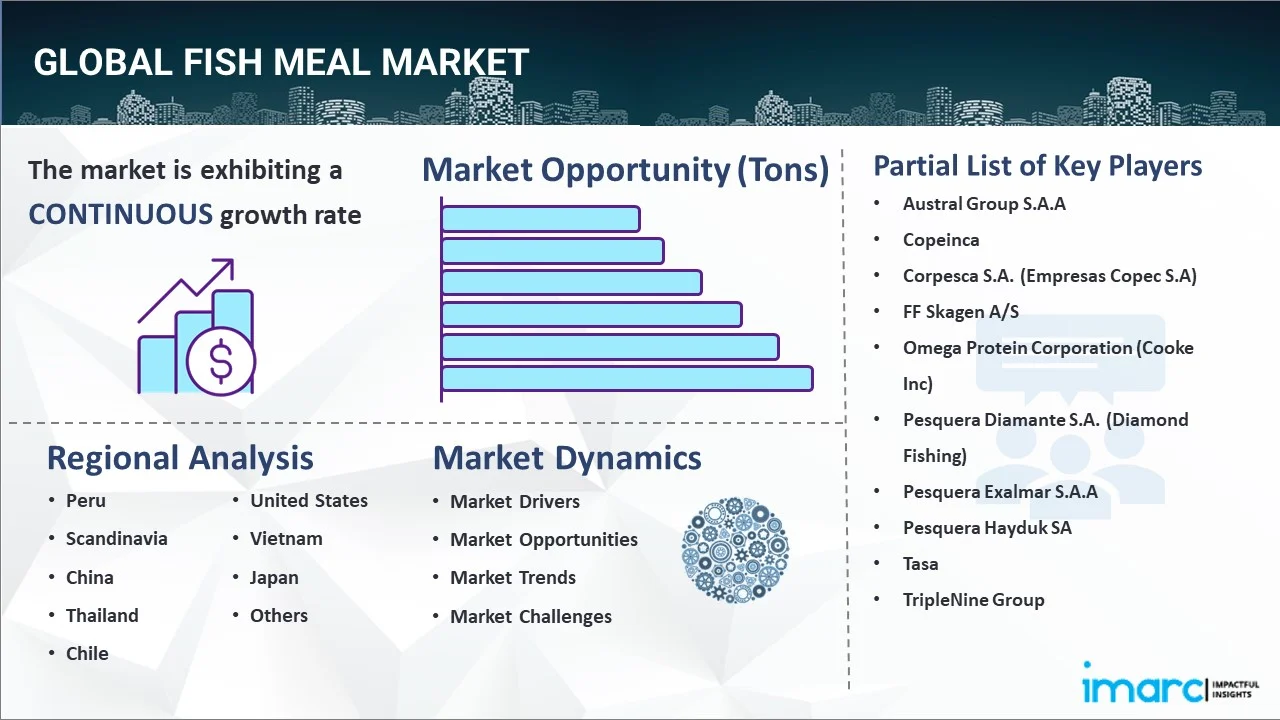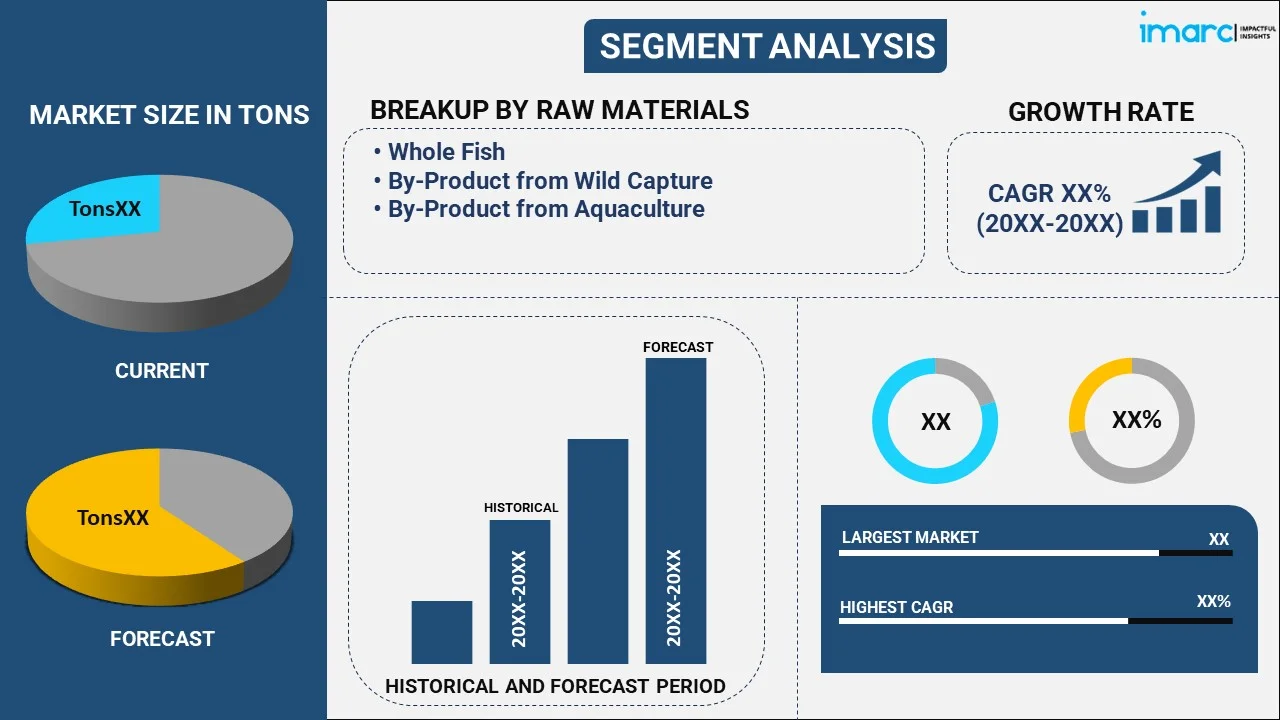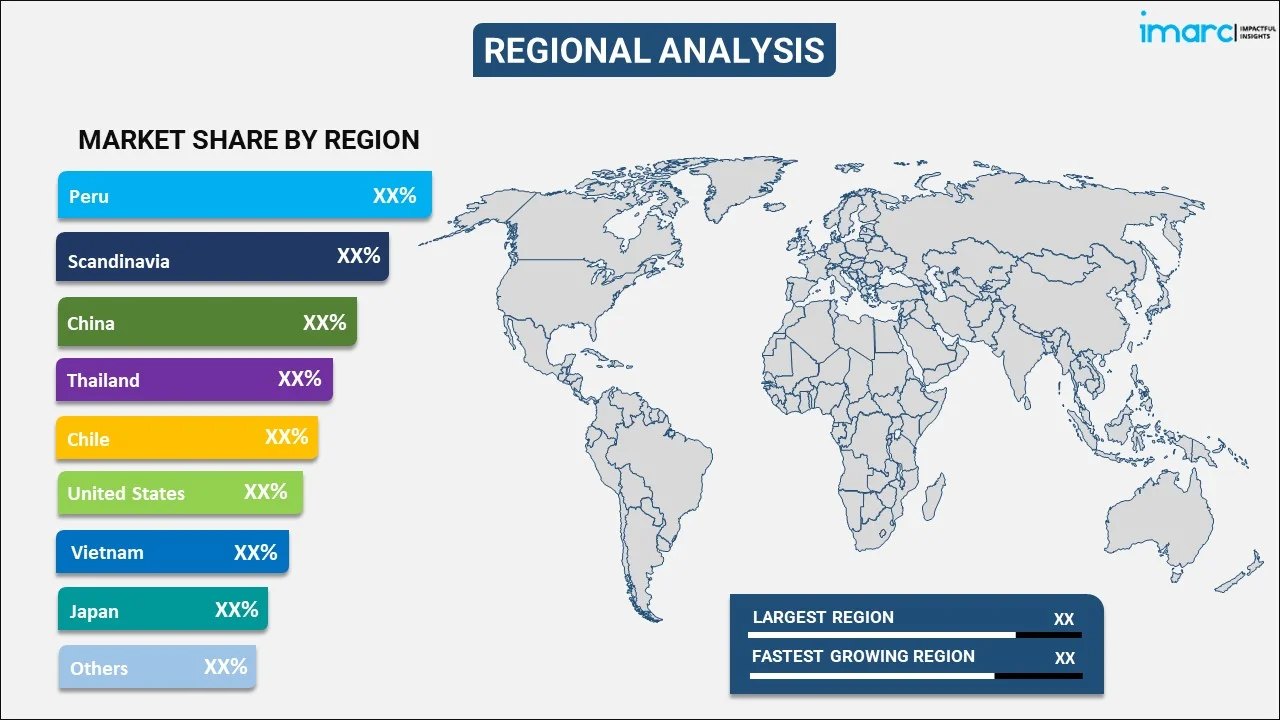
Fish Meal Market Report by Type (Whole Fish, By-Product from Wild Capture, By-Product from Aquaculture), Species (Marine, Trimming), Application (Aquaculture, Swine, Poultry, and Others), and Region 2025-2033
Global Fish Meal Market Size And Trends
The global fish meal market size is projected to exhibit a growth rate (CAGR) of 6.7% during 2025-2033. The rising consumer awareness towards several associated benefits of fish-based ingredients in improving the quality and performance of animal feed is primarily augmenting the market.
|
Report Attribute
|
Key Statistics
|
|---|---|
|
Base Year
|
2024
|
|
Forecast Years
|
2025-2033
|
|
Historical Years
|
2019-2024
|
| Market Growth Rate 2025-2033 | 6.7% |
Fish Meal Market Analysis:
- Major Market Drivers: The expanding aquaculture industry is escalating the demand for high-quality seafood products, which is one of the primary factors propelling the market. Besides this, the growing prevalence of various chronic disorders, owing to the widespread consumption of heavy metals, such as lead, cadmium, mercury, etc., that are present in conventionally cultured animal feed, is also stimulating the adoption of fish meals.
- Key Market Trends: The elevating industrialization of dairy and meat production is increasing the popularity of feed additives, such as fish meal, for boosting metabolism, mitigating disease outbreaks, stimulating reproduction, etc. Additionally, the widespread requirement for naturally sourced alternatives is further acting as a significant growth-inducing factor.
- Competitive Landscape: Some of the prominent companies in the global market include Austral Group S.A.A, Copeinca, Corpesca S.A. (Empresas Copec S.A), FF Skagen A/S, Omega Protein Corporation (Cooke Inc), Pesquera Diamante S.A. (Diamond Fishing), Pesquera Exalmar S.A.A, Pesquera Hayduk SA, Tasa, and TripleNine Group, among many others.
- Geographical Trends: Peru exhibits a clear dominance in the market, owing to the country's abundant marine resources, robust fishing industry, and the elevating need for high-quality fish meal in livestock feed and aquaculture.
- Challenges and Opportunities: One of the main challenges hampering the market is the overfishing of marine resources. However, the implementation of novel fishing practices and strict regulatory measures by government bodies to ensure the long-term viability of the fish population are expected to fuel the market over the forecasted period.

Fish Meal Market Trends:
Improvements in Alternative Protein Sources
The increasing concerns among individuals towards the sustainability of traditional fish meal production are augmenting the demand for alternative protein sources. In August 2023, Goldbloom Inc., one of the alternative protein companies that specialize in the growth of black soldier fly larvae, secured significant funding from the Canadian investment issuer ‘Eat and Beyond’ to provide a sustainably produced protein that can be used to feed livestock and aquaculture. Moreover, a study published in Scientific Reports in January 2024 discusses the potential of microbial community-based protein that is produced from soybean processing wastewater as a value-added feed ingredient for sustainable aquaculture feeds. Apart from this, the rising need for minimizing dependency on wild fish stocks is also acting as another significant growth-inducing factor. For instance, a report published in the journal Aquaculture International in February 2024 unveiled the potential of fermented soybean when replacing fishmeal in shrimp diets. Furthermore, prominent companies are exploring the usage of insect protein and plant-based materials, which are projected to fuel the market in the coming years. For example, in February 2024, Innovafeed, one of the leaders in the production of insect ingredients for high-quality animal feed, inaugurated its North American Insect Innovation Center (NAIIC) in Illinois, U.S., to scale up production and commercialization of insect protein in the country.
Advancements in Processing
The increasing popularity of novel processing methods to enhance the quality and efficiency of fish meal production is stimulating the market. For instance, in November 2023, single-cell protein producer, MicroHarvest, launched a pilot plant facility in Lisbon, Portugal, to commercialize as well as prototype production and testing of aquafeed. Additionally, the widespread adoption of modern techniques to extract nutrients and improve the overall quality of fish meal is also contributing to the fish meal market outlook. For example, in July 2023, the Kerala University of Fisheries and Ocean Studies (Kufos) collaborated with Amala Eco Clean Private Limited, based in Alappuzha, which operates in the field of organic waste management, to introduce an experimental project to produce fish meal from organic waste. In line with this, it aims to prepare the protein required for fish feed from organic waste using black soldier fly larvae. Similarly, in July 2023, NTT Corporation announced a three-step plan, in partnership with the Regional Fish Institute, to produce shellfish and fish that have been fed on home-grown algae in RAS facilities.
Expanding Aquaculture Industry
The rapid growth of the aquaculture industry is stimulating the overall market. According to the IMARC the global aquaculture market size reached 79.3 million tons in 2023. Looking forward, IMARC Group expects the market to reach 116.6 million tons by 2032, thereby exhibiting a growth rate (CAGR) of 4.2% during 2024-2032. Moreover, the escalating adoption of high-quality feed to support the expansion of aquaculture operations is also positively influencing the market. In January 2024, the Singapore Food Agency (SFA) unveiled a tender for two sea-based fish farm plots in the southeastern waters off Pulau Bukom. Besides this, the widespread need for eco-friendly techniques to ensure the long-term viability of fish stocks is further bolstering the global market. For instance, in March 2024, Campbell River, British Columbia-based Poseidon Ocean Systems closed an approximately US$ 20.75 Million Series B round of funding led by Ecosystem Integrity Fund, a sustainability-focused venture capital fund to enhance fish welfare and mitigate damage to ecosystems.
Global Fish Meal Industry Segmentation:
IMARC Group provides an analysis of the key trends in each segment of the market, along with the fish meal market forecast at the global, and regional level for 2025-2033. Our report has categorized the market based on the raw material, species, and application.
Breakup by Raw Material:

- Whole Fish
- By-Product from Wild Capture
- By-Product from Aquaculture
The report has provided a detailed breakup and analysis of the market based on the raw material. This includes whole fish, by-product from wild capture, and by-product from aquaculture.
Whole fish remains a significant source of fish meal, particularly in regions like Peru and Chile, where large-scale industrial fishing is prevalent. However, the industry is increasingly utilizing by-products from wild capture, such as fish offal and trimmings, to enhance sustainability and reduce waste. This approach maximizes harvested fish use and addresses environmental concerns associated with overfishing. Additionally, by-products from aquaculture, such as waste from farmed fish processing, are becoming an important raw material source, reflecting the industry's shift towards a circular economy. By leveraging these diverse raw materials, the fish meal market can meet the growing demand while promoting sustainable practices and resource efficiency. The report's comprehensive analysis highlights the contributions and trends associated with each raw material type, providing valuable insights for stakeholders across the supply chain.
Breakup by Species:
- Marine
- Anchovy
- Sandeel
- Menhaden
- Sprat
- Others
- Trimming
The report has provided a detailed breakup and analysis of the market based on the species. This includes marine (anchovy, sandeel, menhaden, sprat, and others) and trimming.
Marine species are the primary sources of fish meal due to their high protein content and availability. In addition to whole fish, the market also extensively uses trimmings, which include by-products from fish processing operations. These trimmings, sourced from species like tuna, cod, and haddock, offer a sustainable alternative by utilizing parts of the fish that would otherwise be discarded. Companies like Royal DSM are innovating by using fish trimmings to produce high-quality fish meals, thus enhancing sustainability and reducing waste. This detailed species-based analysis underscores the importance of both whole fish and trimmings in meeting the diverse needs of the fish meal market, promoting efficiency and environmental responsibility.
Breakup by Application:
- Aquaculture
- Crustaceans
- Salmon and Trout
- Marine Fish
- Tilapias
- Others
- Swine
- Poultry
- Others
Aquaculture accounted for the largest fish meal market share
The report has provided a detailed breakup and analysis of the market based on the application. This includes aquaculture (crustaceans, salmon and trout, marine fish, tilapias, and others), swine, poultry, and others. According to the report, aquaculture represented the largest market segmentation.
As aquaculture continues to grow, it requires high-quality feed to ensure the healthy and efficient growth of farmed fish and shrimp. Fish meal, known for its rich protein content and excellent digestibility, is a crucial ingredient in aquafeeds. This has led to significant investments and product launches tailored to meet the specific needs of the aquaculture industry. For instance, in December 2023, BioMar launched its Blue Impact line, which incorporates sustainable fish meal sources to support eco-friendly aquaculture practices. These developments highlight the industry's commitment to providing high-performance feed solutions that cater to the growing demands of aquaculture. The reliance on fish meals to boost productivity and sustainability in aquaculture underscores its dominance in the market, driven by the need to support the burgeoning seafood supply chain globally.
Breakup by Region:

- Peru
- Scandinavia
- Denmark
- Norway
- Iceland
- China
- Thailand
- Chile
- United States
- Vietnam
- Japan
- Others
Peru currently dominates the market
The market research report has also provided a comprehensive analysis of all the major regional markets, which include Peru, Scandinavia (Denmark, Norway, and Iceland), China, Thailand, Chile, United States, Vietnam, Japan, and others. According to the report, Peru accounted for the largest market share.
The country's abundant marine resources, advanced processing technologies, and the growing demand for high-quality fish meal are augmenting the market. Peru's rich fishing grounds, particularly for anchovy, provide a consistent and high-volume source of raw material, making it one of the largest fish meal producers. For example, leading companies like Tecnológica de Alimentos S.A. (TASA) leverage these resources to produce a premium fish meal that meets stringent international standards. Additionally, the implementation of sustainable fishing practices and quotas by the Peruvian government ensures the long-term availability of fish stocks, promoting environmental responsibility. The increasing demand from the aquaculture industry, especially in Asia and Europe, further drives the market, as fish meal is a vital ingredient in aquafeeds due to its high protein content and nutritional value. Innovations in processing technologies by COPEINCA enhance product quality and efficiency, solidifying Peru's position as a dominant player in the market.
Competitive Landscape:
The market research report has provided a comprehensive analysis of the competitive landscape. Detailed profiles of all major fish meal market companies have also been provided. Some of the key players in the market include:
- Austral Group S.A.A
- Copeinca
- Corpesca S.A. (Empresas Copec S.A)
- FF Skagen A/S
- Omega Protein Corporation (Cooke Inc)
- Pesquera Diamante S.A. (Diamond Fishing)
- Pesquera Exalmar S.A.A
- Pesquera Hayduk SA
- Tasa
- TripleNine Group
(Please note that this is only a partial list of the key players, and the complete list is provided in the report.)
Fish Meal Market Recent Developments:
- April 2024: SINTEF Energy launched an EU-funded project that involves the process of turning waste from the forestry industry into valuable products for the fish feed industry.
- March 2024: Campbell River, British Columbia-based Poseidon Ocean Systems, closed roughly US$20.75 Million Series B round of funding led by Ecosystem Integrity Fund, a sustainability-focused venture capital fund to enhance fish welfare and mitigate damage to ecosystems.
- February 2024: Innovafeed, one of the providers of insect ingredients for high-quality fish meal, inaugurated its North American Insect Innovation Center (NAIIC) in Illinois, U.S., to scale up production and commercialization of insect protein in the country.
Fish Meal Market Report Scope:
| Report Features | Details |
|---|---|
| Base Year of the Analysis | 2024 |
| Historical Period | 2019-2024 |
| Forecast Period | 2025-2033 |
| Units | Million Tons |
| Scope of the Report | Exploration of Historical Trends and Market Outlook, Industry Catalysts and Challenges, Segment-Wise Historical and Future Market Assessment:
|
| Raw Materials Covered | Whole Fish, By-Product from Wild Capture, By-Product from Aquaculture |
| Species Covered |
|
| Applications Covered |
|
| Countries Covered | Peru, Scandinavia (Denmark, Norway, Iceland), China, Thailand, Chile, United States, Vietnam, Japan, Others |
| Companies Covered | Austral Group S.A.A, Copeinca, Corpesca S.A. (Empresas Copec S.A), FF Skagen A/S, Omega Protein Corporation (Cooke Inc), Pesquera Diamante S.A. (Diamond Fishing), Pesquera Exalmar S.A.A, Pesquera Hayduk SA, Tasa, TripleNine Group, etc. |
| Customization Scope | 10% Free Customization |
| Post-Sale Analyst Support | 10-12 Weeks |
| Delivery Format | PDF and Excel through Email (We can also provide the editable version of the report in PPT/Word format on special request) |
Key Benefits for Stakeholders:
- IMARC’s industry report offers a comprehensive quantitative analysis of various market segments, historical and current market trends, market forecasts, and dynamics of the fish meal market from 2019-2033.
- The research report provides the latest information on the market drivers, challenges, and opportunities in the global fish meal market.
- The study maps the leading, as well as the fastest-growing, regional markets. It further enables stakeholders to identify the key country-level markets within each region.
- Porter's five forces analysis assists stakeholders in assessing the impact of new entrants, competitive rivalry, supplier power, buyer power, and the threat of substitution. It helps stakeholders to analyze the level of competition within the fish meal industry and its attractiveness.
- The competitive landscape allows stakeholders to understand their competitive environment and provides insight into the current positions of key players in the market.
Key Questions Answered in This Report
We expect the global fish meal market to exhibit a CAGR of 6.7% during 2025-2033.
The increasing demand for high-grade feed additives, such as fish meal, to stimulate reproduction, boost metabolism, mitigate disease outbreaks, etc., is primarily driving the global fish meal market growth.
The sudden outbreak of the COVID-19 pandemic has led to the changing consumer inclination from conventional brick-and-mortar distribution channels towards online retail platforms for the purchase of fish meal.
Based on the application, the global fish meal market can be segmented into aquaculture, swine, poultry, and others. Currently, aquaculture holds the majority of the total market share.
On a regional level, the market has been classified into Peru, Scandinavia, China, Thailand, Chile, United States, Vietnam, Japan, and others, where Peru currently dominates the global market.
Some of the major players in the global fish meal market include Austral Group S.A.A, Copeinca, Corpesca S.A. (Empresas Copec S.A), FF Skagen A/S, Omega Protein Corporation (Cooke Inc), Pesquera Diamante S.A. (Diamond Fishing), Pesquera Exalmar S.A.A, Pesquera Hayduk SA, Tasa, and TripleNine Group.
Need more help?
- Speak to our experienced analysts for insights on the current market scenarios.
- Include additional segments and countries to customize the report as per your requirement.
- Gain an unparalleled competitive advantage in your domain by understanding how to utilize the report and positively impacting your operations and revenue.
- For further assistance, please connect with our analysts.
 Inquire Before Buying
Inquire Before Buying
 Speak to an Analyst
Speak to an Analyst
 Request Brochure
Request Brochure
 Request Customization
Request Customization




.webp)




.webp)












